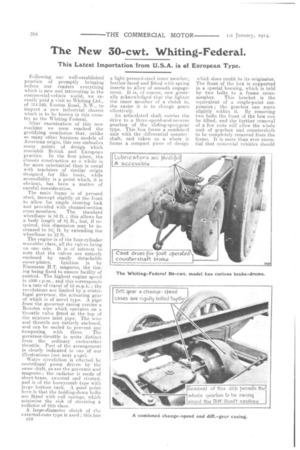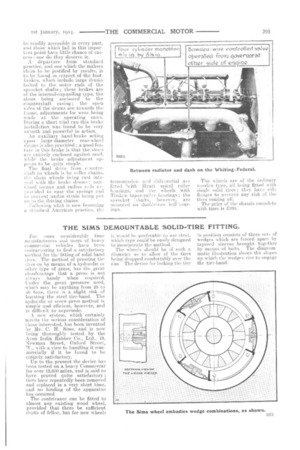The New 30-cwt. Whiting-Federal.
Page 6

Page 7

If you've noticed an error in this article please click here to report it so we can fix it.
This Latest Importation from U.S.A. is of European Type.
Following our well-established practice of promptly bringing before our readers everything which is new and interesting in the commercial-vehicle world, we recently paid a visit to Whiting Ltd., of 231-340, Enston Road, NAT., to inspect a new industrial chassis which is to be known in this country as the Whiting-Federal. After examination of this new machine we soon reached the gratifying conclusion that, unlike so many other business models of American origin, this one embodies many points of design which resemble British and European practice. In the first place, the chassis construction as a whole is far more substantial than is usual with machines of similar origin designed for like loads, while accessibility is a point which, it is obvious, has been a matter of careful consideration.
The main frame is of pressed steel, inswept slightly at the front to allow for ample :steering lock and provided with channel-section cross-members. The standard. wheelbase is 10 ft. ; this allows for a body length of 8i ft., but, if required, this dimension may be increased to 10!.; ft. by extending the wheelbase to 12 ft.
The engine is of the four-cylinder monobloc class, all the valves being on one side. It is of interest to note that the valves are entirely enclosed by easily detachable cover-plates. Ignition is by Eisemann 1I.T. magneto, the timing being fixed to ensure facility of control. The highest engine speed
is 1000 and this corresponds to a rate of travel of 15 ; the revolutions are limited by a centrifugal governor, the actuating gear of which is of novel type. A pipe from the governor easing carries a Bowden wire which operates on a throttle valve fitted at the top of the mixture inlet pipe. The wire and throttle are entirely enclosed, and can be sealed to prevent any tampering with them. The governor-throttle is quite distinct horn the ordinary carburetter throttle. Part of the arrangement is clearly indicated in one of our illustrations (see next page). Water circulation is effected by centrifugal pump driven by the same shaft, as are the governor and magneto ; the radiator is made of sheet-brass, sweated and riveted, and is of the honeycomb type with large bottom tank, A good point here is that the holding-down bolts are fitted with coil swings, which minimize the risk of straining a radiator of this class.
A largediameter clutch of the external-cone type is used ; this has n12 a light pressed-steel inner member, leather-faced and fitted with spring inserts to allow of smooth engagement. It is, of course, now generally acknowledged that the lighter the inner member of a clutch is, the easier it is to change gears effectively. An articulated shaft carries the drive to a three-speed-and-reverse gearbox of the sliding-spuRgear type, This box forms a waif:lin:A unit with the differential countershaft, and taken as • a whole it forms a compact piece of design which does credit to its originator. The front ofthe box is supported in a special housing, which is held by two bolts to a frame cross member. This bracket is the equivalent of a single-point suspension ; the gearbox can move slightly within it. By removing two bolts the front of the box can be tilted, and the further removal of a few nuts will allow the whole unit of gearbox and countershaft to be completely removed from the frame. It is more than ever essential that comercial vehicles should be readily accessible in every part, and those which fail in this important point have little chance of succes5-11or do they deserve it. A departure from standard practice, and one which the makers claim to be justified by results, is to be found in respect. of the footbrakes, which include large churns bolted to the outer ends of the sprocket shafts ; these brakes are of the internal-expanding type, the shoes being anchored to the countershaft casing ; the open sides of the drums are towards the frame, adjustments for wear being made at the operating cams. During a short trial run this brake installation was found to be very smooth and powerful in action.
An auxiliary hand-brake acting upon large-diameter rear-wheel drums is also provided ; a good feature in this brake is that the shoes are entirely enclosed against mud, while the brake adjustment appears to be quite simple.
The final drive from e:nintershaft to wheels is by roller chains. the chain wheels being east intenral with the brake drums', cornLined troctue and radius reds are provided to case the springs and to prevent undue strain being put on to the driving chains.
Following what is now becoming a standard American practice, th. transmission arid dirfeiential are fitted with .11yatt spiral roller bearings, and the wheels with Timken taper-rolln. bearings ; the sprocket shafts, however, are mounted on double-row ball-bearings.
The wheels are of the ordinary wooden type, all being fitted with single solid tires; they have side flanges to prevent any risk of the tires coming off.
The price of the chassis complete with tires is £395.




















